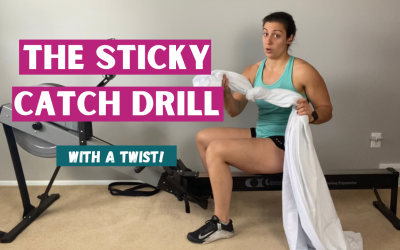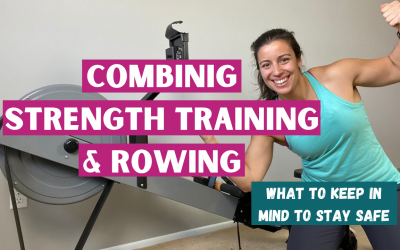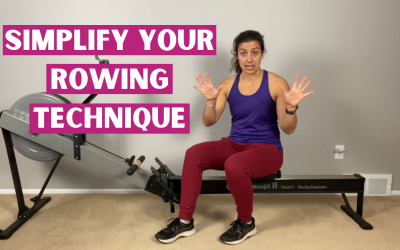Technique Tips for Rowing Safely
Safety is a big deal. When we want to improve our fitness, we don’t want to hurt ourselves in the process. There are a couple of key things to look for in your rowing stroke if you’re wanting to stay as safe as possible. I’ve grouped the technique considerations by body part, as well as some notes on properly warming up and cooling down.
*NOTE*: I am not a doctor nor am I a licensed practitioner. If you are having persistent pain please get it checked out by a licensed professional. I can provide you with technique tips to keep you safe, but I cannot (and will not) diagnose injuries. Your injuries may or may not be from rowing. They may only be aggravated by it.
NECK, SHOULDERS AND BACK
I grouped these body parts together because these technique considerations help improve all of these areas simultaneously.
First, sitting up tall and relaxed throughout our stroke will help you keep these body parts safe. One thing I like to say is to “sit proudly”. I picture someone sitting up tall with their shoulders relaxed and down. Having relaxed shoulders will keep the neck and shoulders from getting tight. Sitting up tall will straighten that back to be able to brace better and keep it safer.
Next, you want to make sure your shoulders stay in front of your hips when your legs start the drive. If you’re not sure what that looks like, check out this post where I have a video showing the reverse pick drill. This drill is helpful with practicing this! The biggest thing here is you don’t want to lean back right when you start your drive. That puts extra strain on your lower back.
What will help with my previous point is bracing your core on the drive. As you drive with the legs, bracing with your core will help you keep those shoulders in front of those hips, as well as take the pressure off of your spine. Now your core muscles are taking that load.
If you’re finding it difficult to sit up straight or keep those shoulders in front of your hips, check how you are sitting on the seat. Are your sit bones on the seat? Or your bum? Check out this video to know the difference. When you start sitting on the seat correctly, it makes it much easier to sit up and pivot forward.
ELBOWS AND WRISTS
Elbow pain can be harder to diagnose. Sometimes a previous injury can be aggravated by rowing.
During the drive, you want straight arms, but not locked out. The rowing stroke is more of a push with the legs than a pull with the arms. The majority of the stroke is using your core and lats to brace the leg drive and then swing the body open. The arms start pulling in once those two things have happened. So pulling early could be a source of elbow pain, or can develop it over time.
Wrist pain can develop if you don’t have a good finish position.
At the finish, you want flat wrists. If your wrists are bent, doing that stroke after stroke can wear them down and cause some pain. It’s not a strong position for your wrists to be in (when they are bent).
To help keep those wrists flat, it’s ideal to finish at the bottom of your sternum. For women, that’s the bottom of your bra, or your bra strap. Finishing any higher will cause those wrists to bend. You may want to get some extra length to your stroke by finishing higher, but that extra inch won’t improve your split by nearly anything. You can have a much stronger pull by finishing lower.
BUTT/HIPS
If you’ve tried rowing, you may be wondering what can be done to help that bum feel a little more comfortable. Some pain may come from sitting up on the seat for a while, while other pain can become sores from things getting sweaty and rubbing together.
We’ve all experienced this butt pain. Thankfully there’s a whole host of suggestions out there you can try. Some sit on a butt pad to help keep those sit bones more comfortable.
For any type of rubbing discomfort, I suggest rowing in spandex shorts without any undergarments underneath. That’s one extra layer that won’t rub. There’s also a lot of anti-chaffing cream out there that you can use to decrease friction in any problem area.
As for your hips, a lot of tightness comes from a technique flaw of pulling ourselves up to the catch. If you’ve ever noticed that you need to pick up your toes to help you get to the next stroke, then you may need some help here.
My number one suggestion is to work on getting that handle past the knees before the knees bend on the recovery. When the arms come away and the body rocks over, now you can control your way up the slide using your hamstrings instead of your toes. When you pull up using your toes, that also activates your hip muscles. Which over time can become very tight from overworking them this way.
KNEES
Some seek out rowing because it’s a low-impact exercise. In order to get this benefit, you need to watch how much strain you put on your knees stroke after stroke.
The biggest thing you can do to keep your knees in good shape is to hit full compression and not go too far. Full compression is when your shins hit vertical at the catch. If your shins go past vertical, then you add additional strain to your knees.
Overcompressing not only hurts your knees but also reduces the power in your stroke. It takes longer to get those heels down to start that leg drive so that extra length to overcompress isn’t adding anything to your stroke. It’s much safer to stop sooner and not overcompress.
If getting to full compression is difficult or painful, it’s ok to stop your stroke sooner. Let the rowing machine meet you where you’re at. You can still get a good workout if you aren’t quite to full compression. It’s better to be safe!
WARM-UP AND COOL DOWN
I couldn’t make a post about staying safe while rowing without mentioning some things on warming up and cooling down. When these two things are done properly, it can help your body be more prepared for your workout as well as recover better afterward.
If you’re getting ready to do shorter, faster intervals, then you need a longer warmup than usual. Make sure you’re getting in some hard strokes, like power 10s, at the pace you’ll be shooting for. For any intervals up to 4 minutes long, I would do a minimum of 10 minutes of rowing. This can be some drills to start and then working on those power 10s.
For longer, steady-state rows, less warm-up is needed. You may only need a 1k warm-up here working up to your goal pace. If this is a timed, all-out longer piece, maybe give yourself a little more warm-up.
Incorporating some active stretches and into your warm up can also help get you feeling loose and ready to go.
STILL HAVING PAIN?
If you’re still having pain and you’ve tried everything mentioned above and more, I recommend scheduling a 1 on 1 session with me so we can go over your technique to see what may be missing. I won’t be able to diagnose any injuries, but I can help get your rowing form to be as safe as possible.
The Sticky Catch Drill – with a twist!
The sticky catch drill is a great drill to feel the connection at the catch in your rowing stroke. And I have a different way of doing it that you may have never seen before. Most of the time, for the sticky catch drill, you can use a strap or something very sturdy...
How to Combine Strength Training and Indoor Rowing Workouts
If you want to up your rowing game with some strength training, then this is the post for you. After purchasing a strength program from a coach, these are some things you want to consider when you're combining your strength and rowing workouts. I'll throw in this...
Simplify Your Rowing Stroke
When you're just starting to learn how to row, it can be overwhelming watching technique videos, especially if it's a follow along drill or follow along workout where the coach is giving a lot of cues. Examples of cues are chest up, shoulders down, arms out then body...



